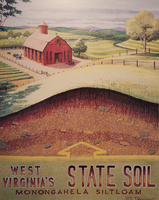 | Back to e-WV
| Back to e-WV
 The West Virginia Encyclopedia
The West Virginia Encyclopedia
 | Back to e-WV
| Back to e-WV
 The West Virginia Encyclopedia
The West Virginia Encyclopedia

Monongahela silt loam is the state soil of West Virginia. It is widespread through the state, occurring on more than 100,000 acres in 45 counties. Described by the U.S. Department of Agriculture as a very deep, moderately well-drained soil, Monongahela silt loam is a prime agricultural soil. It is well suited to the production of cultivated crops as well as hay, pasture, and timber.
Actually a series or family of soils sharing related characteristics, Monohgahela silt loam was first identified in Greene County, Pennsylvania, in 1921. It was named for the Monongahela River, which drains Greene County and much of north-central West Virginia. Monongahela silt loam also occurs in a large region outside the Monongahela River watershed, in parts of several states. The soil derives largely from sandstone and shale, sedimentary rocks formed millennia ago by the siltation of streams. It occurs particularly on terraces but is also present on slopes of as much as 25 percent grade. The soil is slightly acidic.
Monongahela silt loam was designated the official soil of West Virginia by the state legislature in April 1997. Governor Cecil Underwood honored the soil and its advocates by the issuance of a colorful poster in a ceremony in his office in November of the same year.